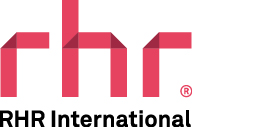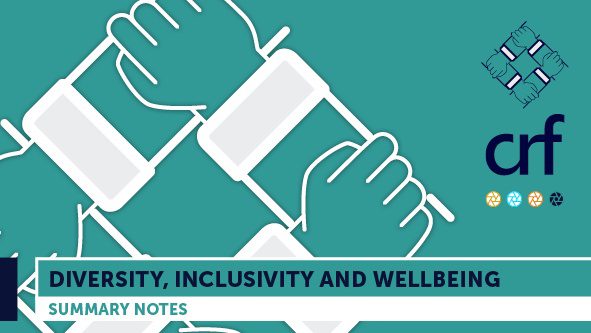D&I and Wellbeing
D&I Supplier Review
This paper came out of a response to a CRF community query on highly-rated D&I supplier recommendations from our members. The aim of it is to understand which third parties our members work with for their D&I strategy, but more importantly the criteria they use for assessing, selecting, and evaluating performance of service providers in this space. The information about providers and services below does not constitute endorsement or recommendation by CRF.
Criteria used to select providers:
We asked our members to share the criteria and strategies they use to select D&I suppliers. They said the following:
- Referring to a set of internal pillars under foundation EDI education, conscious inclusion, and inclusive leadership.
- Breadth of topics they provide and depth of expertise.
- Strong technical and legal knowledge.
- They should provide a strong advisory service – a go-to for questions on how to position complex topics.
- A strong understanding of what other organisations are doing and to be able to bring insights from other businesses.
- Their services must feel actionable and relevant in the day job.
- The ability to help them find the right partners that they can co-create good content with.
- Credible experts.
- Procure experts through a managed learning service which provides a sweeping of the marketplace.
- Net Promoter Score (NPS) to find out their satisfaction measurement.
- The behaviour change potential.
- The ability to adapt to the business evolving over time.
What has worked when selecting suppliers?
Our members also shared the strategies and qualities that they have found to be particularly successful when selecting suppliers.
- Adopting a co-creation and co-collaboration approach.
- Blend of experiential and a more traditional approach to learning.
- A deep understanding of the culture of D&I in legislation and social contexts.
- Creating the right structure from top to bottom and getting feedback from the bottom up.
- Prove D&I gaps with data and then get experts to educate executives on it.
- Transparency on both sides – setting realistic expectations and being honest when they cannot meet your needs.
- Asking the important question to understand the company and what they want to achieve, such as, what are the challenges? What’s the context? What’s come up recently? Who’s the audience, and who do they work with? How does your business work in terms of communication?
- Suppliers who were previously global heads of D&I who move into a consultancy role – adds value from their lived experiences.
- QA has been used as a platform to find the right partners.
What hasn’t worked so well when selecting suppliers?
We also asked our members to give us examples of approaches that haven’t been effective when selecting suppliers, and the consequent advice they would give to other organisations who are at the beginning of their supplier selection process.
- Off-the-shelf content and products feel transactional and impersonal to the company values, and it can alienate learners.
- Sometimes pitched far too high and far too low – pitching too low is not good on ROI.
- Executives at the top table are sometimes not as educated on certain D&I topics, so they end up missing the point with the selection process.
- Overloading people with information due to not having a well-thought strategic approach.
- Suppliers who are not curious about the industry and don’t understand the context of what they’re delivering in the industry.
- You don’t always get the best speaker for the best price – hiring suppliers who are solely trying to promote a product but do not bring the best value.
- When they are too academic or based in models and concepts, as opposed to being pragmatic.
How are members evaluating the performance of service providers in this space?
Our members shared how they evaluate the performance and execution of the D&I services and solutions provided by suppliers.
- Not providing just a tick-box suggestion but creating experiential services that give people practical advice.
- Providing memorable activities that create real change, such as holding a mirror up to people and creating the crucial “squirm” moments around unconscious biases.
- A robust tender and procurement process.
- Net Promoter Score (NPS) to submit how likely they are to recommend their services.
- Checking if they are addressing core trends in the space.
- Participation across the business. The success, attendance, and engagement of supplier events and webinars.
- Are the resources relevant or of use? Webinars, toolkits, research reports, peer learning forums.
- Speakers that are credible and knowledgeable – niche expertise or experience combined with an engaging presentation style where they interact with the audience appropriately.
- International presence.
- Checking references – not just from a logistical point of view but also checking how knowledgeable they are about the current complexities of D&I.
Names of suppliers used by members:
The following CRF partners are experts in the D&I space:

Included included.com

RHR International rhrinternationalconsultants.uk/solutions-diversity
The following suppliers were cited by CRF members as organisations they are currently partnering with – or have in the past. Inclusion on the list does not constitute endorsement or recommendation by CRF.
- The Human Library humanlibrary.org
- Business Disability Forum businessdisabilityforum.org.uk
- The Employers Network for Equality & Inclusion: enei enei.org.uk
- Business in the Community (BITC) bitc.org.uk
- Gary Bloom – Workplace Wellbeing garybloom.co.uk
- Stonewall stonewall.org.uk
- Brook Graham brookgraham.com
- Utopia weareutopia.co
- The Hobbs Consultancy thehobbsconsultancy.com
- Altogether Different altogether-different.com
- Right Management rightmanagement.co.uk
- Moving Ahead moving-ahead.org
- Gender Inclusion Network genderinclusionnetwork.co.uk
- Speakers Corner speakerscorner.co.uk/diversity-equality-speakers
- Chartwell Consulting chartwell-consulting.com
- Henpicked: Menopause in the Workplace menopauseintheworkplace.co.uk
- Diversity Role Models diversityrolemodels.org
- INvolve involvepeople.org
- Inclusive Employers inclusiveemployers.co.uk
- WiHTL – a collaboration community devoted to increasing D&I across Hospitality, Travel and Leisure wihtl.com
- EA Inclusion eainclusion.com
- QA – Diversity and Inclusion initiatives qa.com
- AKD Solutions akdsolutions.com
- Aggie Mutuma from Mahogany Inclusion Partners mahoganyinclusionpartners.com
- LEAD Network lead-eu.net
- CBI cbi.org.uk
- 30% Club 30percentclub.org
- Woman on Boards womenonboards.net
- Open for Business open-for-business.org
- Out & Equal outandequal.org
- The Valuable 500 thevaluable500.com
- PurpleSpace purplespace.org
- UK Confidence Leaders Group disabilityconfident.campaign.gov.uk
- Disability:IN disabilityin.org
- Investing in Ethnicity investinginethnicity.org
- The Networks of Networks tnongroup.com
- National Hispanic Corporate Council nhcchq.org
- International Labour Organisation: Global Business and Disability Network businessanddisability.org
- GlobeSmart globesmart.com
- Educating Matters educatingmatters.co.uk
- Carers UK carersuk.org
Points of reference:
Some of our members highlighted key legislative reviews and literature they use to inform their D&I policies and criteria when selecting suppliers.
- The Department for International Development Charter for Change gov.uk/government/publications/global-disability-summit-charter-for-change
- Hampton-Alexander review – FTSE Women Leaders gov.uk/government/publications/ftse-women-leaders-hampton-alexander-review
- The United Nations LGBTQ+ Standards ohchr.org/EN/Issues/Discrimination/Pages/Biz4LGBTI.aspx
- Ethnic Diversity of UK Boards: The Parker Review gov.uk/government/publications/ethnic-diversity-of-uk-boards-the-parker-review
- Included Impact Report included.com/impact-report/impact-report-2020
MEMBER LOGIN TO ACCESS ALL CRF CONTENT




